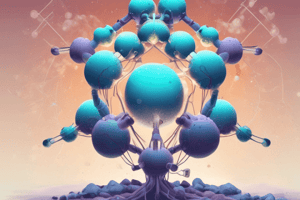Podcast
Questions and Answers
Boiling of water to form steam is a chemical change.
Boiling of water to form steam is a chemical change.
False (B)
Cutting of trees is a physical change.
Cutting of trees is a physical change.
True (A)
Ice, water, and water vapour are chemically different substances.
Ice, water, and water vapour are chemically different substances.
False (B)
Making a fruit salad with raw fruits is an example of a chemical change.
Making a fruit salad with raw fruits is an example of a chemical change.
Dissolving common salt in water is an example of a physical change.
Dissolving common salt in water is an example of a physical change.
What is the characteristic of a solution at the particle level?
What is the characteristic of a solution at the particle level?
What is the term for the component of a solution that dissolves the other component in it?
What is the term for the component of a solution that dissolves the other component in it?
What is an example of a gas in liquid solution?
What is an example of a gas in liquid solution?
What is the characteristic of an alloy that distinguishes it from a pure substance?
What is the characteristic of an alloy that distinguishes it from a pure substance?
What are the two main constituents of air?
What are the two main constituents of air?
Study Notes
Non-Metals and Metalloids
- Non-metals are elements that are not attracted to magnets, examples include hydrogen, oxygen, iodine, carbon, bromine, and chlorine.
- Metalloids are elements that have intermediate properties between metals and non-metals, examples include boron, silicon, and germanium.
Mixtures and Compounds
- Mixtures are formed when elements or compounds combine without forming a new compound, and have a variable composition.
- Compounds are formed when elements react to form a new substance with a fixed composition.
- Mixtures show the properties of their constituent substances, while compounds have totally different properties.
- The constituents of a mixture can be separated fairly easily by physical methods, while the constituents of a compound can only be separated by chemical means.
Purity of Substances
- A substance is considered pure if it has a fixed composition and characteristic properties.
- Examples of pure substances include sodium chloride (salt) and sugar.
- Mixtures contain more than one substance, such as soft drinks and soil.
- The word "pure" on packaging means that the product has no adulteration, but scientifically, it means that the substance is not a mixture.
Types of Mixtures
- Mixtures can be classified based on the nature of their components.
Physical and Chemical Changes
- Physical changes occur without a change in composition, such as melting, boiling, and interconversion of states.
- Chemical changes occur with a change in composition, such as rusting, burning, and dissolving.
- Examples of physical changes include cutting of trees, melting of butter, boiling of water, and passing of electric current.
- Examples of chemical changes include rusting of almirah, boiling of water to form steam, and burning of paper and wood.
Homogeneous and Heterogeneous Mixtures
- A homogeneous mixture has a uniform composition, while a heterogeneous mixture has a non-uniform composition and physically distinct parts.
- Examples of heterogeneous mixtures: mixtures of sodium chloride and iron filings, salt and sulphur, and oil and water.
Solutions
- A solution is a homogeneous mixture of two or more substances.
- Examples of solutions: lemonade, soda water, alloys (e.g. brass), and gaseous solutions (e.g. air).
- In a solution, there is homogeneity at the particle level, meaning the particles of the substances are evenly distributed.
- A solution has a solvent and a solute as its components.
- The solvent is the component that dissolves the other component, usually present in larger amount.
- The solute is the component that is dissolved in the solvent, usually present in lesser quantity.
Examples of Solutions
- Sugar in water: sugar is the solute and water is the solvent.
- Iodine in alcohol (tincture of iodine): iodine is the solute and alcohol is the solvent.
- Aerated drinks like soda water: carbon dioxide is the solute and water is the solvent.
- Air: a homogeneous mixture of gases, with oxygen (21%) and nitrogen (78%) as its main constituents.
Properties of a Solution
- A solution is a homogeneous mixture.
Studying That Suits You
Use AI to generate personalized quizzes and flashcards to suit your learning preferences.
Related Documents
Description
Learn about the characteristics of non-metals, metalloids, mixtures, and compounds in chemistry. Understand their properties and how they differ from one another.




